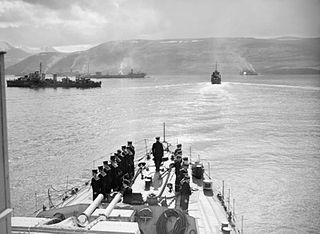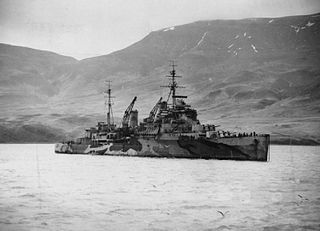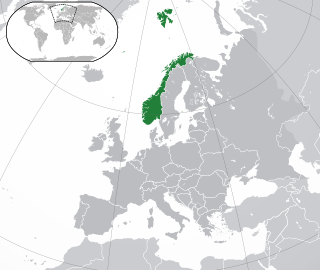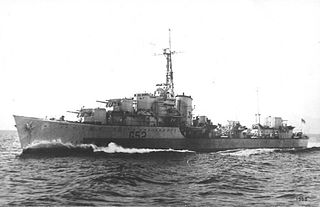
PQ 17 was the code name for an Allied Arctic convoy during the Second World War. On 27 June 1942, the ships sailed from Hvalfjörður, Iceland, for the port of Arkhangelsk in the Soviet Union. The convoy was located by German forces on 1 July, after which it was shadowed continuously and attacked. The First Sea Lord Admiral Dudley Pound, acting on information that German ships, including the German battleship Tirpitz, were moving to intercept, ordered the covering force based on the Allied battleships HMS Duke of York and USS Washington away from the convoy and told the convoy to scatter. Because of vacillation by Oberkommando der Wehrmacht, the Tirpitz raid never materialised. The convoy was the first large joint Anglo-American naval operation under British command; in Churchill's view this encouraged a more careful approach to fleet movements.

The Battle of the North Cape was a Second World War naval battle that occurred on 26 December 1943, as part of the Arctic campaign. The German battleship Scharnhorst, on an operation to attack Arctic convoys of war materiel from the western Allies to the Soviet Union, was brought to battle and sunk by the Royal Navy's battleship HMS Duke of York with cruisers and destroyers, including an onslaught from the destroyer HNoMS Stord of the exiled Royal Norwegian Navy, off the North Cape, Norway.

The Arctic convoys of World War II were oceangoing convoys which sailed from the United Kingdom, Iceland, and North America to northern ports in the Soviet Union – primarily Arkhangelsk (Archangel) and Murmansk in Russia. There were 78 convoys between August 1941 and May 1945, sailing via several seas of the Atlantic and Arctic oceans, with periods with no sailings during several months in 1942, and in the summers of 1943 and 1944.

HMS Trinidad was a Royal Navy Fiji-class light cruiser. She was lost while serving in the Arctic on convoy duty after being damaged escorting PQ 13 in 1942.

The Captain is a 1967 novel by Dutch writer Jan de Hartog. It is a sequel of a sort to his 1940 book Captain Jan, though not having the same characters as the earlier book. Both books deal with the life of sailors in ocean-going tugboats - a field in which the Netherlands has great prominence. The earlier book dealt with the peacetime sailor protagonists' conflict with the exploiting, authoritarian Kwel Shipping Company which demands feudal-like fealty from its employees. In the present book this goes on under the extreme wartime conditions of WWII, with the Kwel company having escaped the occupied Netherlands and moved operations to London, its vessels contracted to take part in various Allied operations - particularly, the highly dangerous Arctic convoys. Even under these extreme conditions, the conflict between tyrannical bosses and rebellious sailors is still there, interweaving with the vast war against Nazi Germany.
Four British Royal Navy ships have been called HMS Ulysses:
Convoy PQ 1 was the second of the Arctic Convoys of World War II by which the Western Allies supplied material aid to the Soviet Union in its fight with Nazi Germany. The convoy sailed from Hvalfiord in Iceland on 29 September 1941 and arrived at Archangelsk on 11 October 1941.

PQ 13 was a British Arctic convoy that delivered war supplies from the Western Allies to the USSR during World War II. The convoy was subject to attack by German air, U-boat and surface forces and suffered the loss of five ships, plus one escort vessel. Fifteen ships arrived safely.

Convoy PQ 15 was an Arctic convoy sent from Iceland by the Western Allies to aid the Soviet Union during the Second World War. The convoy sailed in late April 1942, reaching the Soviet northern ports after air attacks that sank three ships out of twenty-five.

Convoy PQ 14 was an Arctic convoy sent from Britain by the Western Allies to aid the Soviet Union during the Second World War. Convoys from Britain had been despatched since August 1941 and advantage had been taken of the perpetual darkness of the Arctic winter. German operations against the convoys had been muted due to the need to support Operation Barbarossa, confidence in imminent victory and the small size of the convoys. In late 1941 and early 1942 the Luftwaffe and Kriegsmarine had reinforced Norway with aircraft and ships.

Convoy PQ 12 was an Arctic convoy sent from Great Britain by the Western Allies to aid the Soviet Union during World War II. It sailed in March 1942, reaching Murmansk despite a sortie against it by the German battleship Tirpitz. All ships arrived safely.
Convoy PQ 11 was an Arctic convoy sent from Great Britain by the Western Allies to aid the Soviet Union during World War II. It sailed in February 1942 and arrived in Murmansk without loss.
Convoys PQ 9 and 10 were Arctic convoys sent from Great Britain by the Western Allies to aid the Soviet Union during World War II. They sailed together in early February 1942 and arrived in Murmansk without loss.

Convoy JW 55B was an Arctic convoy sent from Great Britain by the Western Allies to aid the Soviet Union during World War II. It sailed in late December 1943, reaching the Soviet northern ports at the end of the month. All ships arrived safely.
Convoy JW 51B was an Arctic convoy sent from United Kingdom by the Western Allies to aid the Soviet Union during World War II. It sailed in late December 1942, reaching the Soviet northern ports in early January 1943.

HMS Matchless was a M-class destroyer built during World War II. After the war she was placed in reserve until August 1957 and eventually sold to the Turkish Navy, who renamed her TCG Kılıç Ali Paşa. She was struck from the Turkish Navy list and scrapped in 1971.

Convoy QP 11 was an Arctic Convoy of World War II, made up of merchant ships returning from the Soviet Union to Britain after delivering their cargo to the Soviet Union. The convoy consisted of 13 merchant ships, escorted by 18 warships. The convoy was attacked by German destroyers and submarines, suffering the loss of one merchant ship as well as the light cruiser HMS Edinburgh. The German forces lost the destroyer Z7 Hermann Schoemann.
Convoy QP 10 was an Arctic convoy of World War II, consisting of empty merchant ships returning from the Soviet Union after delivering their cargo there. The convoy consisted of 16 merchant ships and an escort of nine warships. The convoy departed Murmansk on 10 April 1942 and arrived in Reykjavik on 21 April. The convoy was attacked by German U-boats and aircraft, resulting in the loss of four merchant ships. Another ship, Stone Street, was damaged by air attack and forced to turn back to the Kola Inlet. The convoy's escorts shot down six German planes and damaged another during the course of the voyage. Later, six merchant ships from Convoy PQ 14 joined QP 10.

HMS Dianella was a Flower-class corvette of the Royal Navy. She served during the Second World War.











